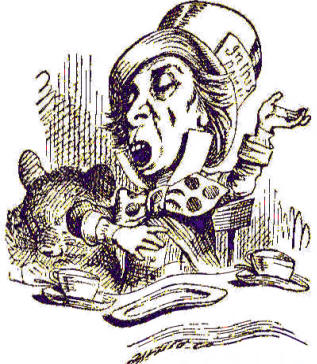Lewis Carroll
frequently used common expressions, songs, nursery rhymes, etc., as the basis for characters in his stories. The origin of the phrase, it's believed, is that hatters really did go mad. The chemicals used in hat-making included mercurous nitrate, used in curing felt. Prolonged exposure to the mercury vapors caused mercury poisoning. Victims developed severe and uncontrollable muscular tremors and twitching limbs, called 'hatter's shakes'; other symptoms included distorted vision and confused speech. Advanced cases developed hallucinations and other psychotic symptoms.

Few people who use the phrase today realise that there’s a story of human suffering behind it; the term actually derives from an early industrial occupational disease. Felt hats were once very popular in North America and Europe; an example is the top hat. The best sorts were made from beaver fur, but cheaper ones used furs such as rabbit instead.
A complicated set of processes was needed to turn the fur into a finished hat. With the cheaper sorts of fur, an early step was to brush a solution of a mercury compound — usually mercurous nitrate — on to the fur to roughen the fibres and make them mat more easily, a process called carroting because it made the fur turn orange. Beaver fur had natural serrated edges that made this unnecessary, one reason why it was preferred, but the cost and scarcity of beaver meant that other furs had to be used.
Whatever the source of the fur, the fibres were then shaved off the skin and turned into felt; this was later immersed in a boiling acid solution to thicken and harden it. Finishing processes included steaming the hat to shape and ironing it. In all these steps, hatters working in poorly ventilated workshops would breathe in the mercury compounds and accumulate the metal in their bodies.
We now know that mercury is a cumulative poison that causes kidney and brain damage. Physical symptoms include trembling (known at the time as hatter’s shakes), loosening of teeth, loss of co-ordination, and slurred speech; mental ones include irritability, loss of memory, depression, anxiety, and other personality changes. This was called mad hatter syndrome.
It’s been a very long time since mercury was used in making hats, and now all that remains is a relic phrase that links to a nasty period in manufacturing history. But mad hatter syndrome remains common as a description of the symptoms of mercury poisoning.
World Wide Words is copyright © Michael Quinion, 1996–2007.
All rights reserved. Contact the author if you want to reproduce this piece, but first see our advice page, which also has notes about linking. Your comments and corrections are welcome.
Page created 3 March 2001.